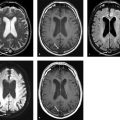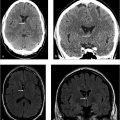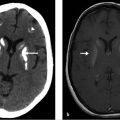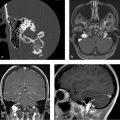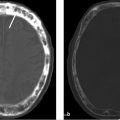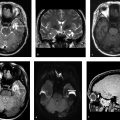11 Simple Pineal Cyst
11.1 Case Presentation
11.1.1 History and Physical Examination
A 32-year-old woman presents to ER with head trauma.
The patient is alert and oriented. Cranial nerves II–XII are grossly intact with no focal neurologic deficit.
11.1.2 Imaging Findings and Impression
Axial CT scan of the head without contrast show a well-defined and rounded cystic lesion (white arrows) measures 5 × 6 mm in the pineal region with focal calcification along with anterior wall (▶ Fig. 11.1).

MR images of the brain with and without contrast show a well-defined and rounded cystic lesion in the pineal region. The lesion is hyperintense on the axial T2-weighted image (▶ Fig. 11.2a) and hypointense on noncontrast T1-wegihted image (▶ Fig. 11.2b) with incomplete suppression on the axial fluid-attenuated inversion recovery (FLAIR) image (▶ Fig. 11.2c). Diffusion-weighted image shows no evidence of restricted diffusion (▶ Fig. 11.2d). Axial (▶ Fig. 11.2e) postcontrast T1-weighted images demonstrate minimal, linear enhancement of the wall of the cyst. No solid component can be identified. Importantly, there is no evidence of enlargement of the ventricles to suggest obstruction.

11.2 Differential Diagnosis
Simple pineal cyst:
It is a benign cyst involving the pineal gland usually measuring less than 1 cm with no enhancing nodular, solid component. It usually follows the cerebrospinal fluid (CSF) signal intensity on all MRI sequences but may not completely suppress on T2-weighted FLAIR sequences. It often has concentric calcification involving the wall of the cyst.
It does not result in obstruction of CSF flow nor symptomatic compression of the tectal plate, which could result in upgaze paralysis.
Pineocytoma:
Pineocytomas are benign pineal parenchymal tumors frequently seen in females.
They are round or oval well-demarcated tumors measuring less than 3 cm in diameter.
CT: hypodense to intermediate-density lesion arising from the pineal gland with peripheral calcifications.
MRI: hypo- to isointense on T1-weighted images and isointense to the brain parenchyma on the T2-weighted images. 1
Larger tumors can demonstrate cystic degeneration within them.
Solid component shows vivid enhancement on MR after gadolinium administration.
Pineoblastoma 2 :
Pineoblastomas are malignant pineal parenchyma tumors typically seen in children with a slight female predilection.
They are ill-defined heterogeneous tumors usually larger than 3 cm with an aggressive growth pattern.
CT: A large heterogeneous, irregularly marginated tumor that is hyperdense as compared to the normal brain parenchyma attributed to the high cellularity. Calcification is often seen peripherally dispersed within the tumor.
MRI: Isointense on T1- and T2-weighted images with marked heterogeneous enhancement following gadolinium administration. As this tumor has high cellularity, it appears dark on apparent diffusion coefficient (ADC) maps.
Imaging of the entire neuraxis is recommended as approximately 40 to 50% of these tumors can develop leptomeningeal spread.
Germinoma:
Germinoma is the most common intracranial germ cell tumor common in children and young adults with higher predilection in males.
CT: hyperdense due to high cellularity. It tends to engulf pineal calcifications centrally within the mass.
MRI: isointense to hyperintense on the T2-weighted and isointense on T1 weighted-images and demonstrate homogeneous enhancement following contrast administration.
They can have a cystic component and appear darker on ADC maps. They are associated with elevated levels of placental alkaline phosphatase and beta-human chorionic gonadotropin (beta-hCG) in blood.
Arachnoid cyst:
Arachnoid cysts are benign cystic lesions filled with CSF with an imperceptible wall and presumed to be arising from arachnoid cells of the meninges.
They are extra-axial lesions that commonly occur in the subarachnoid space.
They are most commonly found in the region of the anterior temporal pole, but can be seen in the pineal region in some cases.
CT: well-circumscribed cystic lesions with an imperceptible wall.
MRI: cyst follows CSF signal intensity on all sequences.
Epidermoid cyst:
Epidermoid cysts are benign cystic lesions arising from inclusion of ectodermal elements during neural tube closure.
They are extra-axial lesions most commonly occurring in the cerebellopontine cisterns.
They are nonenhancing, well-circumscribed lobulated slow-growing tumors.
CT: The density of the epidermoid cysts approximates 0 HU and can seem identical to CSF. Calcification is seen in 10 to 20% of cases.
MRI: Isointense to CSF on T2- and T1-weighted images with incomplete suppression (dirty signal) on FLAIR images:
On diffusion-weighted images, it appears bright with corresponding hypointensity on ADC images due to keratin.
Stay updated, free articles. Join our Telegram channel

Full access? Get Clinical Tree


